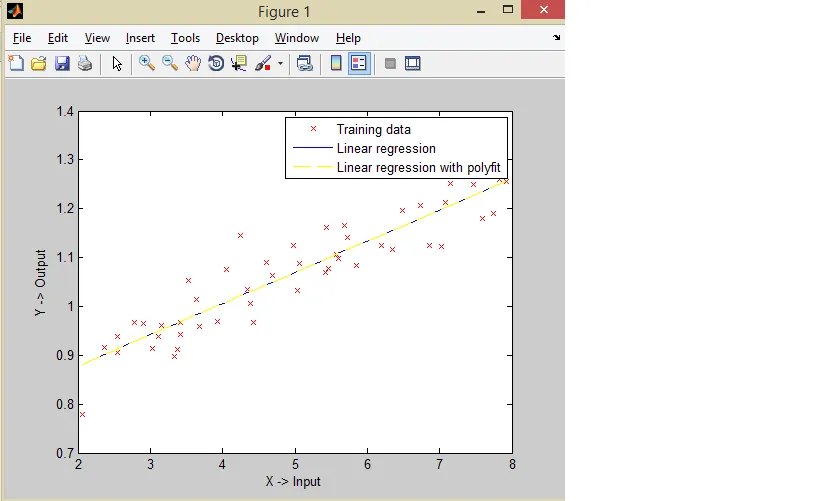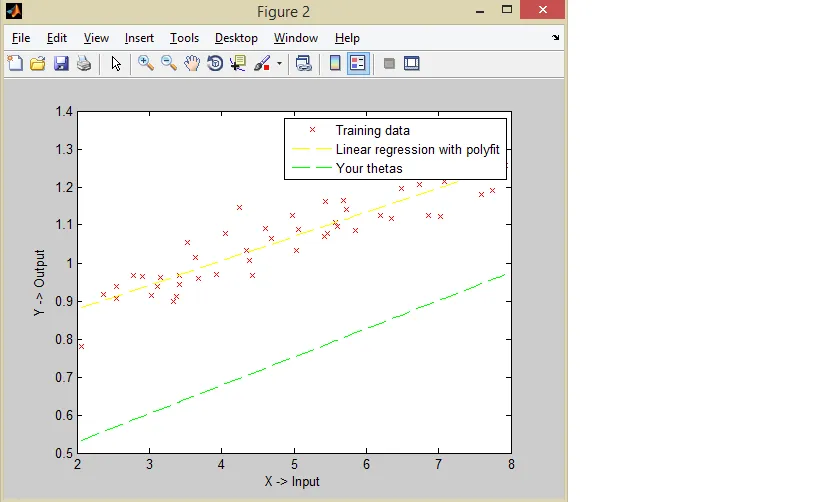我已经查看了许多stackoverflow上的代码,并在同一行上编写了自己的代码。但是存在一些问题,我无法理解。为了分析目的,我正在存储theta1和theta2的值以及成本函数。可以从这个Openclassroom页面下载x和Y数据,它们以.dat文件的形式提供,您可以在记事本中打开。
%Single Variate Gradient Descent Algorithm%%
clc
clear all
close all;
% Step 1 Load x series/ Input data and Output data* y series
x=load('D:\Office Docs_Jay\software\ex2x.dat');
y=load('D:\Office Docs_Jay\software\ex2y.dat');
%Plot the input vectors
plot(x,y,'o');
ylabel('Height in meters');
xlabel('Age in years');
% Step 2 Add an extra column of ones in input vector
[m n]=size(x);
X=[ones(m,1) x];%Concatenate the ones column with x;
% Step 3 Create Theta vector
theta=zeros(n+1,1);%theta 0,1
% Create temporary values for storing summation
temp1=0;
temp2=0;
% Define Learning Rate alpha and Max Iterations
alpha=0.07;
max_iterations=1;
% Step 4 Iterate over loop
for i=1:1:max_iterations
%Calculate Hypothesis for all training example
for k=1:1:m
h(k)=theta(1,1)+theta(2,1)*X(k,2); %#ok<AGROW>
temp1=temp1+(h(k)-y(k));
temp2=temp2+(h(k)-y(k))*X(k,2);
end
% Simultaneous Update
tmp1=theta(1,1)-(alpha*1/(2*m)*temp1);
tmp2=theta(2,1)-(alpha*(1/(2*m))*temp2);
theta(1,1)=tmp1;
theta(2,1)=tmp2;
theta1_history(i)=theta(2,1); %#ok<AGROW>
theta0_history(i)=theta(1,1); %#ok<AGROW>
% Step 5 Calculate cost function
tmp3=0;
tmp4=0;
for p=1:m
tmp3=tmp3+theta(1,1)+theta(2,1)*X(p,1);
tmp4=tmp4+theta(1,1)+theta(2,1)*X(p,2);
end
J1_theta0(i)=tmp3*(1/(2*m)); %#ok<AGROW>
J2_theta1(i)=tmp4*(1/(2*m)); %#ok<AGROW>
end
theta
hold on;
plot(X(:,2),theta(1,1)+theta(2,1)*X);
我正在获取值为theta的内容。
在0.0373和0.1900时,它应该是0.0745和0.3800。
这个值大约是我期望值的两倍。

